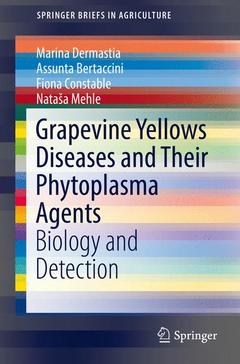Grapevine Yellows Diseases and Their Phytoplasma Agents, 1st ed. 2017 Biology and Detection SpringerBriefs in Agriculture Series
Langue : Anglais
Auteurs : Dermastia Marina, Bertaccini Assunta, Constable Fiona, Mehle Nataša

This work is to compile our current knowledge on GY phytoplasma biology at the genomic, transcriptomics, proteomics and metabolomics level, as well as to summarize the approaches for their detection.Phytoplasma are the most poorly characterized plant pathogenic bacteria from the Mollicutes class. In recent years new biostatistics and bioinformatics approaches have improved our understanding of their biology and interactions with host grapevines and a great improvement has been made toward their molecular detection, both in laboratories and on-site. They have a broad range of plant hosts among the monocots and dicots, and diseases of many important crops are associated with these pathogens. At least ten taxonomically unrelated phytoplasmas, one of them a quarantine pest in Europe, have been associated with grapevine yellows diseases (GY), which have great economic impact on viticulture worldwide.
Phytoplasmas – dangerous and intriguing bacteria.- Worldwide distribution and identification of grapevine yellows diseases.- Grapevine yellows phytoplasmas in Europe.- Grapevine yellows phytoplasmas in America.- Grapevine yellows phytoplasmas in Africa.- Ggrapevine yellows phytoplasmas in Australia.- Interactions between grapevines and grapevine yellows phytoplasmas BNp and FDp.- How phytoplasmas interact with their hosts, based on analysis of their genomes.- Pre-symptomatic grapevine responses to grapevine yellows phytoplasma infection.- Ultrastructure of phloem infected with grapevine yellows phytoplasmas.- Infection of grapevine with grapevine yellows phytoplasmas affects photosynthesis.- Grapevine yellows phytoplasma infection is associated with prominent changes in carbohydrate metabolism.- Grapevine yellows phytoplasma infection affects the plant-energy-associated network.- Changed concentrations of amino acids in infected vein-enriched grapevine samples.- Changes in the flavonoid pathway in grapevineyellows phytoplasma infected grapevines.- Induced salicylic-acid-dependent systemic acquired resistance in grapevines infected with grapevine yellows phytoplasmas.- The recovery and oxidative-stress phenomena.- Detection of phytoplasmas associated to grapevine yellows diseases in research and diagnostics.- Biological tests.- Microscopy techniques.- Immunological approaches.- Molecular approaches .- Step-by-step routine detection of grapevine yellows phytoplasmas
Prof. Marina Dermastia, National Institute of Biology, Ljubljana, Slovenia
Dr. Nataša Mehle, National Institute of Biology, Ljubljiana, Slovenia
Fiona Constable Ph.D., Biosciences Research Division, Bundoora, Australia
Prof. Assunta Bertaccini, University of Bologna, Plant Pathalogy, Bologna, Italy
Broaden our understanding of GY phytoplasma biology and mechanisms by which they cause GY Reinforce basic principles of GY with new biostatistics approaches Treat both theoretical and practical aspects of grapevine infections with phytoplasmas Summarize the latest molecular approaches for GY phytoplasma detection (e.g. real-time PCR, ddPCR, LAMP), both in laboratories and on-site
Date de parution : 02-2017
Ouvrage de 99 p.
15.5x23.5 cm
Thèmes de Grapevine Yellows Diseases and Their Phytoplasma Agents :
© 2024 LAVOISIER S.A.S.


